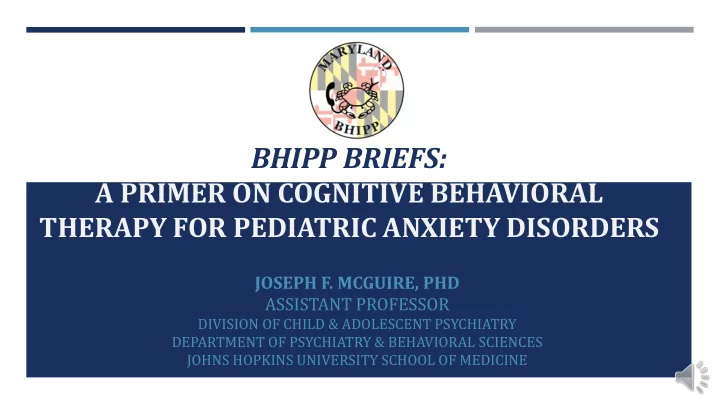

BHIPP BRIEFS: A PRIMER ON COGNITIVE BEHAVIORAL THERAPY FOR PEDIATRIC ANXIETY DISORDERS JOSEPH F. MCGUIRE, PHD ASSISTANT PROFESSOR DIVISION OF CHILD & ADOLESCENT PSYCHIATRY DEPARTMENT OF PSYCHIATRY & BEHAVIORAL SCIENCES JOHNS HOPKINS UNIVERSITY SCHOOL OF MEDICINE
OBJECTIVES Differentiate clinical from non-clinical anxiety in children 1. Recognize the “core” components of cognitive behavioral therapy (CBT) 2. Overview a “typical course” of CBT and treatment considerations 3. Please call our BHIPP telephone consultation line ( 855-MD-BHIPP ) for specific- treatment related questions.
CLINICAL VERSUS NON-CLINICAL ANXIETY Fear and anxiety are adaptive Fear and anxiety are common Natural response to many situations Circumscribed to specific events Clinical versus non-clinical anxiety Frequency and Intensity Distress / Interference Duration
CLINICAL VERSUS NON-CLINICAL ANXIETY Clinically Significant Anxiety & Childhood Anxiety Disorders Separation anxiety Specific phobias Social anxiety Generalized anxiety Panic disorder / agoraphobia Anxiety related conditions Selective Mutism Obsessive-Compulsive Disorder Trauma / Post-Traumatic Stress Disorder
CLINICAL VERSUS NON-CLINICAL ANXIETY Screening tools in primary care Screen for Child Anxiety and Related Disorders (≥ 25) “When in doubt, refer out” Psychological / Psychiatric evaluation for Anxiety Clinical interview to determine diagnostic criteria
COGNITIVE BEHAVIORAL THERAPY (CBT) Two primary evidence-based treatments SSRIs---covered in previous BHIPP Brief Exposure-based Cognitive Behavior Therapy (CBT) Exposure-based CBT for pediatric anxiety Structured approach to treatment Efficacious in clinical trials Effective in community practice
COGNITIVE BEHAVIORAL THERAPY (CBT) Psychological education about child/adolescent anxiety Relaxation training Cognitive strategies Exposures or “behavioral experiments” Homework assignments
COGNITIVE BEHAVIORAL THERAPY (CBT) “Typical” course of CBT Psycho-education Symptom hierarchy development Relaxation training Cognitive strategies Exposures Related CBT skills incorporated into treatment as needed
COGNITIVE BEHAVIORAL THERAPY (CBT) “Typical” CBT session Weekly Interval events and homework review Presentation of new skill Practice skill in session w/ corrective feedback Homework assignment Caregiver involvement
CONSIDERATIONS WHEN RECOMMENDING CBT TO FAMILIES Patient and family readiness for treatment Prior “therapy” attempts Access and availability of CBT providers
CONCERNS RELATED TO SCHOOL REFUSAL School avoidance and refusal are common problems Comprehensive assessment needed to determine cause Tailor skills to address cause/concern Common examples Fears related to performance performance exposure Fears of embarrassment embarrassment exposures Fears related to contamination contamination exposure
QUESTION A 11-year-old girl presents with her mother who reports that her daughter has a generalized anxiety diagnosis. When you ask about treatment, she describes that her daughter has been seeing “someone for the past year”. When you ask her mother to describe what goes in in treatment, which of the following sounds most like a CBT session: A. “She usually goes into therapy by herself, and I don’t know what they do in there.” B. “She gets to talk about her problems and sometimes feels better” C. “She learns skills to deal with her anxiety, and gets assigned homework that I help her do at home” D. “She sees the doctor once a month who talks to her for a bit”
QUESTION A 11-year-old girl presents with her mother who reports that her daughter has a generalized anxiety diagnosis. When you ask about treatment, she describes that her daughter has been seeing “someone for the past year”. When you ask her mother to describe what goes in in treatment, which of the following sounds most like a CBT session: A. “She usually goes into therapy by herself, and I don’t know what they do in there.” B. “She gets to talk about her problems and sometimes feels better” C. “She learns skills to deal with her anxiety, and I help her practice some skills at home” D. “She sees the doctor once a month who talks to her for a bit”
SUMMARY Anxiety is common in children and adolescents When “clinically significant”, there are two evidence-based treatments Exposure-based CBT is an efficacious and effective treatment for children and adolescents with anxiety disorders In a structured format, patients and families develop skills to manage anxiety in CBT
QUESTIONS?: CALL BHIPP! Offering support to pediatric primary care providers through free: Telephone consultation: M-F, 9am- 5pm ( 855-MD-BHIPP) Resource & referral support Training & education Regionally specific social work co-location (Salisbury University) Supported by Maryland Department of Health, Behavioral Health Administration More information at: www.mdbhipp.org
Recommend
More recommend